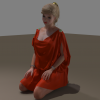Frank Petrexa
Tribune
I guess I should also mention that the "model" reminded me of some old American animated cartoon characters--Dudley Doright of the Mounties and Roger Ramjet.
Found this video elsewhere and thought it a rather fun dash through both the changing nature of Roman warfare and a useful pointer to quite how long a period is covered with the simple notion "Roman".
(No offense is intended to the RCMP, of course.)


Last edited:






 )
)